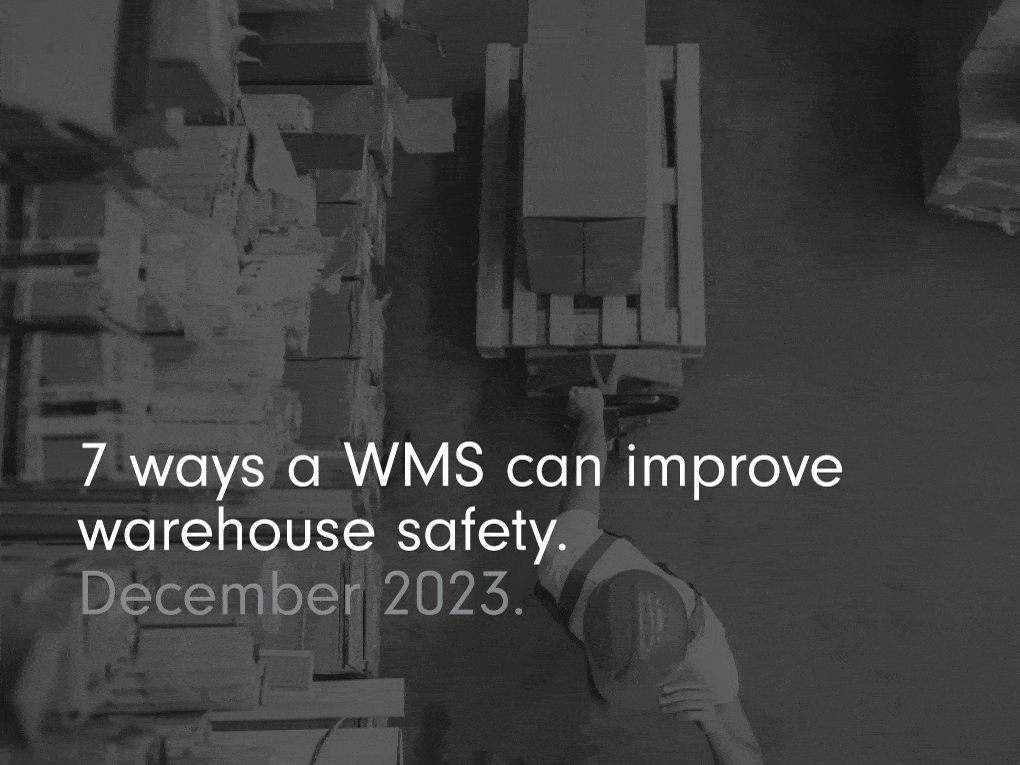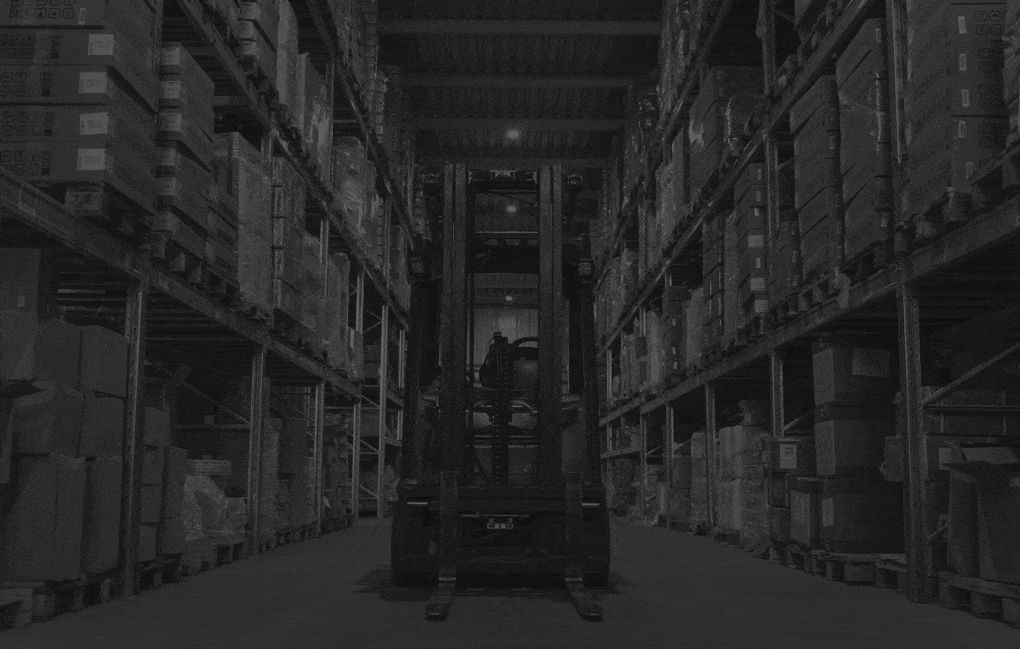
7 ways a WMS can improve warehouse safety.

In a busy warehouse environment, ensuring worker safety and preventing accidents is paramount. Challenges like trip hazards, forklift incidents and improper storage of goods are commonly encountered.
Warehouses already have established health and safety measures and follow precautionary practices to avert risk and prevent injuries. But to further bolster warehouse safety, a WMS provides features that can make a substantial difference.
Here are seven ways that using a WMS can improve warehouse safety and help you manage safety measures, inspection and accountability practices.
1. Effective stock management and real-time visibility.

Having well-organised stock helps reduce warehouse safety risks. It promotes a clean, efficient and orderly warehouse that minimises the chances of accidents and injuries.
With stock stored in designated locations and clearly labelled, warehouse clutter is reduced and aisles are clear of trip hazards. This makes it easier for employees to move around safely.
Using RFID or barcode technology in conjunction with your WMS, brings accurate, real-time tracking of your stock. This real-time visibility can help aid the prevention of accidents, preventing poorly stacked or wrongly located inventory, as well as precariously placed objects or misplaced items.
2. Enhanced warehouse layout and optimised space utilisation.

A WMS helps in efficiently organising your warehouse space and the stock within it. With items stored in appropriate locations, there is a reduced need for excessive aisle space. This limits congestion in the aisles, which can lead to accidents and can block emergency exit routes.
With more efficient stock organisation, you will see improved utilisation of your warehouse space. This means less hazardous overcrowding. Adequate space also allows for safer movement of equipment like forklifts and reduces the risk of collisions.
3. Accurate stock information.

Proper organisation typically goes hand in hand with accurate stock management. Knowing exactly what items you have in stock and where they are located reduces the need for last-minute searches, which can be chaotic and rushed, leading to accidents.
A WMS promotes warehouse safety by ensuring everything has its place and is stored correctly. Employees can therefore quickly locate items without needing to search through disorganised bins, stacks or shelves. Your stock is easier to see and to access, reducing the likelihood of accidents caused by falling objects or employees bumping into things.
4. Efficient materials and goods handling.

A WMS can organise your stock in a way that involves the logical placement of items based on factors like their size, weight and frequency of use. This makes it easier for staff to use materials handling equipment efficiently, reducing the risk of injuries related to heavy lifting or awkward movements.
For instance, your WMS can ensure that heavy items are never placed at height or that bulky goods are strategically located to ensure easy storage and retrieval. Using a WMS means that your staff can carry out their tasks safely and with precision.
5. Preventing accidents from damaged goods.

Storing hazardous materials – such as toxic substances, corrosive chemicals, fireworks or flammable goods – comes with inherent risks. Any spillage or damage to your stock can escalate into a major incident with serious consequences for warehouse safety.
Using a WMS, you can significantly reduce the likelihood of your items being damaged due to mishandling or improper storage. With meticulous organisation and tracking capabilities, the WMS ensures that hazardous materials are carefully and properly stored, handled and transferred within your warehouse.
6. Efficient allocation of resources.

Overcrowding in the warehouse can lead to accidents. With more people, vehicles and equipment filling the aisles and moving about, there is a higher risk of collisions and a greater risk that workers need to take evasive action.
A WMS optimises resource allocation, scheduling the flow of people and equipment and streamlining your warehouse activities. It efficiently assigns tasks to staff and allocates the use of certain equipment and vehicles, therefore optimising the activities in the warehouse. With unnecessary movements minimised, warehouse safety is enhanced thanks to a smoother and more organised flow, with reduced congestion and fewer hazards.
A WMS can schedule the use of forklifts, conveyors and other materials handling equipment, ensuring that they are only used at certain times. This prevents equipment bottlenecks and congestion that can cause collisions and injuries.
People can be managed in the same way. By prioritising orders based on urgency and proximity, a WMS minimises congestion around high-demand areas, like shipping docks or packing stations, reducing the potential for accidents. This efficient resource allocation ensures that only necessary personnel and equipment are in a specific area at any given time.
7. Ensuring regulatory compliance.

There are many safety regulations and standards that require warehouses to store or manage their stock in a certain way. For example, hazardous chemicals need to be stored in compliance with Control of Substances Hazardous to Health (COSHH) regulations; pharmaceuticals providers need to adhere to the Falsified Medicines Directive (FMD); and food safety regulations prescribe temperature management, cleanliness and pest control.
A WMS helps ensure you are compliant with your industry’s warehouse safety protocols and regulations by monitoring processes and flagging deviations in real-time. This not only avoids legal issues, but also contributes to a safer work environment.
For example, devices and sensors in storage areas can be continuously monitored. If temperatures move out of the specified range, the WMS can trigger alerts, allowing immediate corrective action to prevent spoilage or compromise of product quality.
With accurate tracking of expiry dates and lot numbers, a WMS ensures that products are used or shipped in a first-in, first-out (FIFO) manner, reducing waste and preventing you from distributing out of date goods.
Enhance your warehouse safety using Körber WMS.

A WMS is a powerful tool to help you improve warehouse safety. In a safe and efficient warehouse, every aspect operates with precision and order. Aisles are clear and free of clutter and goods are neatly organised, minimising hazards by maximising space for both vehicles and workers.
Staff move efficiently, guided by the WMS that optimises their tasks and ensures that heavy or bulky items are stored and handled correctly. The WMS monitors materials and storage conditions to prevent mishandling and maintains compliance with safety regulations through monitoring processes and notifications of deviations.
A warehouse that is managed by a WMS is a safer warehouse. For more information on how Körber WMS could promote warehouse safety within your operation, call us on 020 8819 9071 or get in touch for a demonstration.




